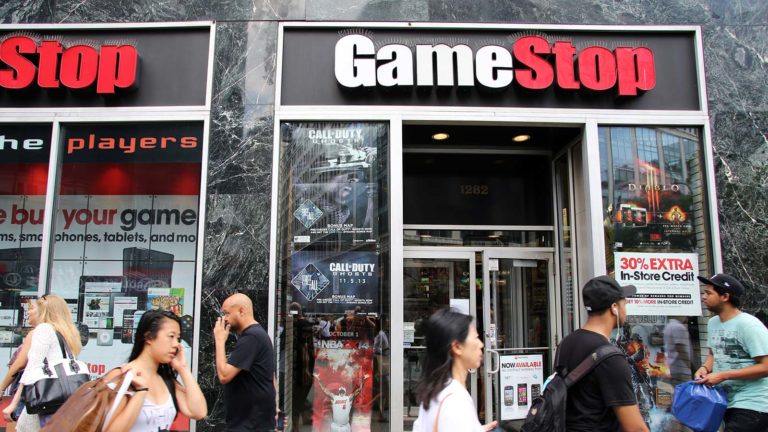When GameStop (NYSE:GME) reports earnings on March 21 after markets close, Wall Street expects a damp squib. Analysts anticipate revenues of only $2.18 billion, 3.2% less than last year’s figures. And net income should clock in at a -$48.5 million loss. Fewer new console games… a reduced store count… bad news from suppliers… we’re probably seeing no fireworks display this quarter.
But try telling that to any GameStop investor. By noon on Monday, no fewer than 22,000 bullish short-dated options had already changed hands. And the number of outstanding March 24 calls has seen open interest increase as we move closer to their expiration date.
That’s because GameStop has attracted the most interesting of investors:
Speculative day traders looking to profit from near-term volatility.
These traders have already pushed GameStop’s stock up 7% since Thursday. And although speculators tend to sell out immediately after earnings, the retailer’s low float makes an “accidental” short squeeze in GME stock far more likely than people realize.
GME Stock and the Gamma Squeeze Risk
Picture an ordinary short squeeze. Short sellers sell too many shares in a company and then are forced to close out when prices start rising. This involves buying stock (since the short sellers initially have a negative position), creating a feedback loop of more purchasing.
GameStop experienced this in January 2021, when overeager hedge funds sold short around 93% of the company’s float. Reddit investors piled in, and the stock’s subsequent 20x rise now has multiple movie deals in the works.
Today’s sequel is slightly different. GameStop “only” has 22% of its shares sold short this time.
But short squeeze risks remain just as high.
Around a quarter of GameStop’s float is now directly registered with its transfer agent — a product of retail investors reducing the number of short shares available. And call options now play a prominent role. These leveraged bets mean that even $100 of call buying can turn into $1,000 or more of market-maker purchasing.

GameStop short shares availability hit zero on March 20. Source: Fintel.io
Here’s why. Imagine we’re a New York Stock Exchange market maker whose only job is to fulfill options orders. We like our job, and we’re pretty good at it.
One day, a punter asks for 1,000 call options on GameStop with a $20 strike price. We both know that GameStop reports earnings within 24 hours and that a $5 increase in share price will make these calls worth negative $2 to us call sellers. (That’s the difference between the $20 strike and the $22 GME price). A $10 increase in share price would make the option worth -$7, and so on. (Don’t worry about the math… it’s this next part that is important)
As market makers, we do two things to reduce our risk:
- We ask for a significant premium… say 53 cents. Even if prices jump to $20.53, we can still walk away without any losses.
- We buy shares in GameStop. A more advanced technique is to take the $53,000 premium (53 cent premium * 100 shares per contract * 1,000 contracts) and invest a portion of that in the underlying GME stock. That way, if shares do rise above $20.53, we can offset losses from our short calls with profits from our long stock position.
That second part is quite clever… until
everyone starts doing the same thing. Options require more offsetting positions the closer in-the-money they become, which forces market makers to buy more stock as prices rise. That causes even more buying pressure. And voila… a gamma squeeze.
Call options buyers could “accidentally” start another GME squeeze without realizing it.
Wealth Hazards
None of this, of course, changes GameStop’s long-term prospects. Even if shares rose to $20… $50… $100 (and management increased its authorized share count in time), there’s only so much that fresh capital can do. The company already has around $1 billion in cash and virtually no long-term debt besides operating leases.
GameStop’s new management has also failed to reinvigorate the business. Its belated push into NFTs, Web 3.0 gaming, and cryptocurrency has fallen short. And revenues continue to decline as gamers migrate to buying digital versions. The company needs an Elon Musk-like personality to shake up its business.
Then there’s the issue of pleasing the short-term traders. In February, a similar flurry of near-expiration option buying sent shares of fellow meme stock AMC Entertainment (NYSE:AMC) from $6 to over $8. But prices quickly declined again when speculators cashed out of their calls. AMC now trades for around $4.
Gamma squeezes, it turns out, cuts both ways.
What’s Next for GME Stock?
In the expected case, GameStop’s struggling business will disappoint against Wall Street’s Q4 estimates. Many other retailers have already announced poor Q4 results and even worse guidance. These are negatives sign for GameStop; shares could fall under $10 on bad news.
But short sellers should realize that this is a bet not worth taking. If GameStop surprises Wall Street, the intense buying could spark a gamma squeeze. And if that happens, you can be sure that Seth Rogen will have another meme stock movie script on his hands.
Bottom line: Be careful of a potential squeeze in GameStop’s volatile stock.
On the date of publication, Tom Yeung did not hold (either directly or indirectly) any positions in the securities mentioned in this article. The opinions expressed in this article are those of the writer, subject to the InvestorPlace.com Publishing Guidelines.
